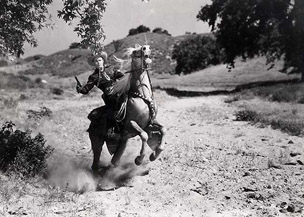|
|
Classic Movie Review: Under Western StarsBy Jason BarneyAugust 11, 2014
Rogers obviously wins, and heads to Washington, D.C. No other issues are on his docket except the lack of water back home. The nature of politics and wheeling and dealing are explored when the new representative learns he must grab the attention of Congressman Marlo, whose support is critical. Greedy and not too concerned with the plight of the average man, the wealthy Mr. Fairbanks works against Rogers’ efforts. During an important scene, Rogers gives a video presentation about the severity of the drought and Fairbanks reveals that some of the footage was not from Rogers’ home area. In an honest defense of his methods, and as part of the charm of this story, we learn his old stomping grounds are so remote no filming has ever happened there. Rogers becomes desperate when Congressmen Marlo, tainted by the villain’s meddling, fails to grasp the extent of the situation. He calls upon local landowners and ranchers to reveal how desperate everyone is. Even for something produced in 1938, the scenes exposing the Dust Bowl are very convincing. Blowing dirt and sand squeeze through slightly open doors. Once fertile land is dead and gray, like a graveyard. The final confrontation at the end is a bit silly, and does not fit well with the lightheartedness of Rogers’ character or style of the movie, but this is a minor complaint. Under Western Stars provides some pretty good entertainment and is viewable as a historical tool. Movie fans can sample a singing western and be entertained by political themes sadly alive and well in the present. Mr. Fairbanks, the wealthy dam owner, can easily be associated with the concerns about corporate greed. The political attitudes are more tolerable than the gridlock Washington can’t seem to let go of each day. And the backdrop of Under Western Stars, featuring the ravages of the Dust Bowl and drought, really strikes home when stories about the dire situation in present day California are in the news. That state is going through its worst dry spell in recorded history, with many water reservoirs at less than 50% capacity. It’s striking how events are so similar almost 70 years after the film was made. Black and white story telling may have been left behind, but the issues seem strangely familiar. Over the years, Under Western Stars has picked up an accolade or two. After it was released, the song “Dust” was nominated for an Academy award. In 2009, the classic was selected for the National Film Registry by the Library of Congress for being an important icon in American film history. Such a designation preserves the original work, allowing it to stand above countless other movies. All in all, Under Western Stars is quite enjoyable. They just don’t make films like this anymore.
|

|
|
|

|
Thursday, October 31, 2024
© 2024 Box Office Prophets, a division of One Of Us, Inc.


